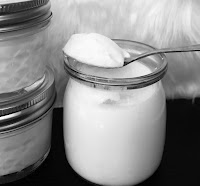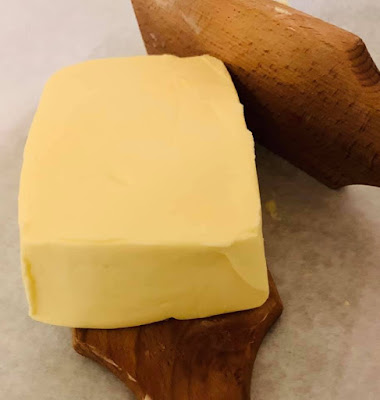No Strain, No Thermometer, Thick, Quick Yogurts in the Instant Pot (SCD friendly)
I’ve made yogurt for years (I'm still struggling with dropping the "h") and always followed the tried and tested methods we read about online.
I (like many I see on forums) also believed the “post-processing strain" was inevitable. Whether shorter for a runnier product or longer for Greek, it was very common for a yogurt to look perfectly set and done until it was stirred. At this point the yogurt would become runnier as any separated whey was recombined, hence the hanging to catch the whey.
But let's be honest, we're all busy - homemade yogurt is amazing, but when you've got a busy job and or kids and cooking isn't your ideal downtime, the novelty quickly wears off.
Was it possible I wondered, to make yogurt in a more convenient way?
Operation Yogurt ensued.
I tested several different milks including Jersey, organic full fat pastuerised,they're fattening and linked with type 2 diabetes. I tested different times, heating methods, cold starts, varying amounts of starter and so on.
organic full fat UHT and organic full fat raw; I haven't tested any low fat or fat free milks as
From this I'm going to bring you my THREE favourite (read as easiest, quickest and tastiest) methods of making dairy yogurt depending on what sort of final result you want.
First let's cover IP yogurt basics.
Live yogurt as we know contains bacteria - in order to be called "yogurt" it has to contain the strains Lactobacillus bulgaricus and Streptococcus thermophilus. Within these two groups there are numerous sub-strains and beyond this manufacturers can add different strains to influence the taste (mild or tart), consistency (thick or pour-able), the time taken to ferment, or to include specific bacteria people want to consume.
Different bacteria grow optimally at different temperatures, potentially some will grow more rapidly and crowd out others - leaving a gloopy, stringy or unpleasant tasting yogurt.
 As shop products are not designed to be used as starters, you can hit lucky and get one that contains strains that live harmoniously together longer-term, but others will have a very short life-span and will start to "fail" (or produce substandard yogurt) within 2 or 3 cycles of reusing it as a starter for the next batch.
As shop products are not designed to be used as starters, you can hit lucky and get one that contains strains that live harmoniously together longer-term, but others will have a very short life-span and will start to "fail" (or produce substandard yogurt) within 2 or 3 cycles of reusing it as a starter for the next batch.
When we ferment a product it typically takes a batch or two for things to "settle", that is achieve optimal taste and texture. This means when using shop starters the final product in my opinion, never becomes as good as using a traditional starter.
Powdered Starter
Far more reliable when it comes to making lots of yogurt is to buy a powdered (dehydrated) starter. Many of these contain strains that co-exist well together and again you can choose a different type of starter depending on what you want to achieve. Some still have some limitations as to lifespan (such as 5 gallons of milk), others can potentially be reused forever!
If the bacteria can indefinitely continue batch after batch and consistently provide good results - it's called a "heirloom strain". These are typically traditional varieties that have been produced for generations.
Read more about starters and heirloom strains here.
I've tried a few different powdered starters, the last one I wasn't massively impressed with and I knew I didn't want bifido strains this time; so for this experiment I decided to try a new one (the other 4 sachets are now stored in the freezer where they'll be fine long past their date). This starter is also suitable for those following the SCD diet.
Equipment needed:
2) A thick, yogurt that can be adjusted slightly depending on the milk used. If you use whole organic milk, it ends up similar to "set yogurt" in the UK, or "French set yogurt" I believe it's called elsewhere. Super smooth and can be stirred to create a runnier consistency. Using jersey milk results in a yogurt somewhere in between greek and set that's creamy when stirred. No pre-boiling or straining is required (we use the steam function on the pot). Great everyday yogurt that stays creamy and "spoon-able" even if you add maple syrup or honey.
3) A creamy yogurt that can be enjoyed as a loose set, or stirred as per the video to make it comparable to a typical runny shop-brought brand (rhymes with Leo). This is a cold start yogurt (no pre-heating required at all), is beyond easy, quick and is a fantastic every day yogurt. Like store brands do, this does become thinner and runnier with the addition of a runny sweetener like honey - however that's not always a bad thing as it makes this perfect for yogurt pouches or blending in smoothies.
I (like many I see on forums) also believed the “post-processing strain" was inevitable. Whether shorter for a runnier product or longer for Greek, it was very common for a yogurt to look perfectly set and done until it was stirred. At this point the yogurt would become runnier as any separated whey was recombined, hence the hanging to catch the whey.
But let's be honest, we're all busy - homemade yogurt is amazing, but when you've got a busy job and or kids and cooking isn't your ideal downtime, the novelty quickly wears off.
Was it possible I wondered, to make yogurt in a more convenient way?
Operation Yogurt ensued.
I tested several different milks including Jersey, organic full fat pastuerised,they're fattening and linked with type 2 diabetes. I tested different times, heating methods, cold starts, varying amounts of starter and so on.
organic full fat UHT and organic full fat raw; I haven't tested any low fat or fat free milks as
From this I'm going to bring you my THREE favourite (read as easiest, quickest and tastiest) methods of making dairy yogurt depending on what sort of final result you want.
First let's cover IP yogurt basics.
The Starter
It's very popular to use a shop bought yogurt to use as a starter. I've done this myself many times, it's good if you're stuck and want to make yogurt now - is it ideal? In my opinion no.Live yogurt as we know contains bacteria - in order to be called "yogurt" it has to contain the strains Lactobacillus bulgaricus and Streptococcus thermophilus. Within these two groups there are numerous sub-strains and beyond this manufacturers can add different strains to influence the taste (mild or tart), consistency (thick or pour-able), the time taken to ferment, or to include specific bacteria people want to consume.
Different bacteria grow optimally at different temperatures, potentially some will grow more rapidly and crowd out others - leaving a gloopy, stringy or unpleasant tasting yogurt.
 As shop products are not designed to be used as starters, you can hit lucky and get one that contains strains that live harmoniously together longer-term, but others will have a very short life-span and will start to "fail" (or produce substandard yogurt) within 2 or 3 cycles of reusing it as a starter for the next batch.
As shop products are not designed to be used as starters, you can hit lucky and get one that contains strains that live harmoniously together longer-term, but others will have a very short life-span and will start to "fail" (or produce substandard yogurt) within 2 or 3 cycles of reusing it as a starter for the next batch.When we ferment a product it typically takes a batch or two for things to "settle", that is achieve optimal taste and texture. This means when using shop starters the final product in my opinion, never becomes as good as using a traditional starter.
Powdered Starter
Far more reliable when it comes to making lots of yogurt is to buy a powdered (dehydrated) starter. Many of these contain strains that co-exist well together and again you can choose a different type of starter depending on what you want to achieve. Some still have some limitations as to lifespan (such as 5 gallons of milk), others can potentially be reused forever!
If the bacteria can indefinitely continue batch after batch and consistently provide good results - it's called a "heirloom strain". These are typically traditional varieties that have been produced for generations.
Read more about starters and heirloom strains here.
I've tried a few different powdered starters, the last one I wasn't massively impressed with and I knew I didn't want bifido strains this time; so for this experiment I decided to try a new one (the other 4 sachets are now stored in the freezer where they'll be fine long past their date). This starter is also suitable for those following the SCD diet.
Equipment needed:
- Instant Pot Electric Pressure Cooker or Similar
- Glass Yogurt Pots*
- Kitchen Jug for 1 litre milk (stainless steel like this chilled in the refrigerator helps milk to cool more rapidly, only for method 1) OR
- Bowl in bowl of ice (optional to cool milk rapidly, only for method 1 or 2)
- Tiny whisk: Optional but makes things easier for methods 2 and 3
There are a number of options for yogurt pots.
- Pots like this or like this with a plastic lid are reasonably priced and good if you want to use your product at home. As the lids can't be heated, if you want to make yoghurt number two, you'd need a heat resistant lid (they don't need to fasten securely, just cover to prevent any condensation dripping in), or as I did in the absence of anything else, pop one of these over the top of each jar. For best results leave a gap at the top of these jars at the measurement line, perfect for adding toppings later.
- Pots with metal lids are ideal for all three types and more secure for carrying out and about. If you don't need space to add chunky toppings, these are the cutest size for popping in lunches.
- I had the best results using jars 200 ml and smaller. You can use larger but it may be slightly less set.
The Different Yogurts
1) A luscious stand your spoon up. super thick and creamy Greek yogurt. When stirred it's like one of the luxury extra creamy shop brands (here in the UK). It doesn't need straining, BUT you do have to spend a bit more time on stage one, heating the milk as instructed.
2) A thick, yogurt that can be adjusted slightly depending on the milk used. If you use whole organic milk, it ends up similar to "set yogurt" in the UK, or "French set yogurt" I believe it's called elsewhere. Super smooth and can be stirred to create a runnier consistency. Using jersey milk results in a yogurt somewhere in between greek and set that's creamy when stirred. No pre-boiling or straining is required (we use the steam function on the pot). Great everyday yogurt that stays creamy and "spoon-able" even if you add maple syrup or honey.
3) A creamy yogurt that can be enjoyed as a loose set, or stirred as per the video to make it comparable to a typical runny shop-brought brand (rhymes with Leo). This is a cold start yogurt (no pre-heating required at all), is beyond easy, quick and is a fantastic every day yogurt. Like store brands do, this does become thinner and runnier with the addition of a runny sweetener like honey - however that's not always a bad thing as it makes this perfect for yogurt pouches or blending in smoothies.



Comments
Post a Comment